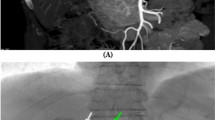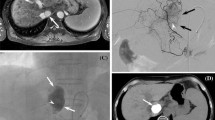Abstract
There are usually multiple caudate arteries arising from the right, left, and middle hepatic arteries, and they are frequently connected to each other. Therefore, hepatocellular carcinoma (HCC) in the caudate lobe is frequently fed by multiple branches arising from different origins. HCC located in the Spiegel lobe is usually fed by the caudate arteries derived from the right and/or left hepatic artery. HCC in the paracaval portion is mainly fed by the caudate artery derived from the right hepatic artery; with low frequency, it is fed by the caudate artery derived from the left hepatic artery. HCC in the caudate process is usually fed by the caudate artery derived from the right hepatic artery. Because of the complexity and overlap of vascular territories, the tumor-feeding branch of a recurrent HCC lesion in the caudate lobe frequently changes on follow-up arteriograms. In addition, several extrahepatic collateral vessels supply the recurrent tumor. To perform effective transcatheter arterial chemoembolization (TACE) for HCC in the caudate lobe, radiologists should have sufficient knowledge of vascular anatomy supplying HCC in the caudate lobe.
Similar content being viewed by others
References
Tanaka S, Shimada M, Shirabe K, Maehara S, Tsujita E, Taketomi A, et al. Surgical outcome of patients with hepatocellular carcinoma originating in the caudate lobe. Am J Surg 2005;190:451–455.
Shimada M, Matsumata T, Maeda T, Yanaga K, Taketomi A, Sugimachi K. Characteristics of hepatocellular carcinoma originating in the caudate lobe. Hepatology 1994;19:911–915.
Shibata T, Maetani Y, Ametani F, Kubo T, Itoh K, Konishi J. Efficacy of nonsurgical treatments for hepatocellular carcinoma in the caudate lobe. Cardiovasc Intervent Radiol 2002;25:186–192.
Yamakado K, Nakatsuka A, Akeboshi M, Takaki H, Takeda K. Percutaneous radiofrequency ablation for the treatment of liver neoplasms in the caudate lobe left of the vena cava: electrode placement through the left lobe of the liver under CT-fluoroscopic guidance. Cardiovasc Intervent Radiol 2005;28:638–640.
Terayama N, Miyayama S, Tatsu H, Yamamoto T, Toya D, Tanaka N, et al. Subsegmental transcatheter arterial embolization for hepatocellular carcinoma in the caudate lobe. J Vasc Interv Radiol 1998;9:501–508.
Yoon CJ, Chung JW, Cho BH, Jae HJ, Kang SG, Kim HC, et al. Hepatocellular carcinoma in the caudate lobe of the liver: angiographic analysis of tumor-feeding arteries according to subsegmental location. J Vasc Intev Radiol 2008;19:1543–1550.
Mizumoto R, Suzuki H. Surgical anatomy of the hepatic hilum with special reference to the caudate lobe. World J Surg 1998;12:2–10.
Takayasu K, Muramatsu Y, Shima Y, Goto H, Moriyama N, Yamada T, et al. Clinical and radiologic features of hepatocellular carcinoma originating in the caudate lobe. Cancer 1986;58:1557–1562.
Miyayama S, Matsui O, Kameyama T, Hirose J, Konishi H, Choto S, et al. Angiographic anatomy of arterial branches to the caudate lobe of the liver; with special reference to its effect on transarterial embolization for hepatocellular carcinoma. Jpn J Clin Radiol 1990;35:353–359 (in Japanese).
Kumon M. Anatomy of the caudate lobe with special reference to portal vein and bile duct. Acta Hepatol Jpn 1985;26:1193–1199 (in Japanese).
Matsui O, Takashima T, Kadoya M, Hirose J, Kameyama T, Choto S, et al. CT anatomy of para-caval portion of the caudate lobe of the liver. Nippon Igaku Hoshasen Gakkai Zasshi 1988;48:841–846 (in Japanese).
Stapleton GN, Hickman R, Terblanche J. Blood supply of the right and left hepatic ducts. Br J Surg 1998;85:202–207.
Miyayama S, Matsui O, Taki K, Minami T, Ryu Y, Ito C, et al. Arterial blood supply to the posterior aspect of segment IV of the liver from the caudate branch: demonstration at CT after iodized oil injection. Radiology 2005;237:1110–1114.
Miyayama S, Yamashiro M, Okuda M, Yoshie Y, Nakashima Y, Ikeno H, et al. Main bile duct stricture occurring after transcatheter chemoembolization for hepatocellular carcinoma. Cardiovasc Intervent Radiol 2010 Jan 8. [Epub ahead of print].
Ishimaru H, Ishimaru K, Mitarai K, Koshiishi T, Matsuoka Y, Egawa A, et al. Application of coaxial micro-balloon catheter (Attendant) for treatment of hepatocellular carcinoma. Jpn J Intervent Radiol 2007;22:72–75 (in Japanese).
Author information
Authors and Affiliations
Corresponding author
About this article
Cite this article
Miyayama, S., Yamashiro, M., Yoshie, Y. et al. Hepatocellular carcinoma in the caudate lobe of the liver: variations of its feeding branches on arteriography. Jpn J Radiol 28, 555–562 (2010). https://doi.org/10.1007/s11604-010-0471-8
Received:
Accepted:
Published:
Issue Date:
DOI: https://doi.org/10.1007/s11604-010-0471-8




